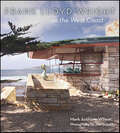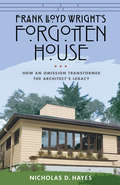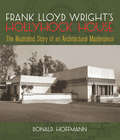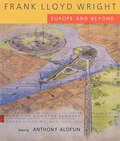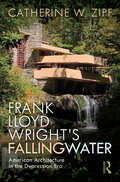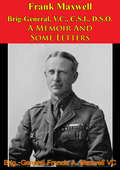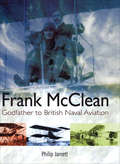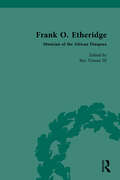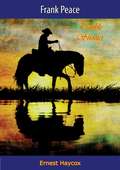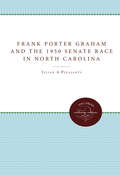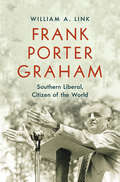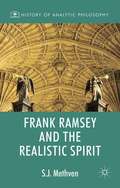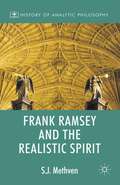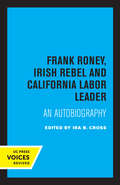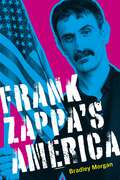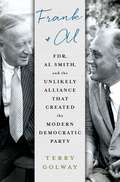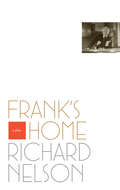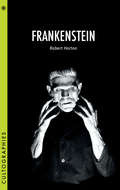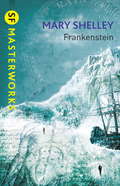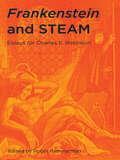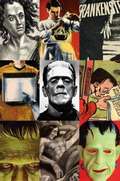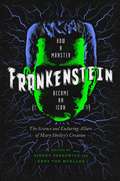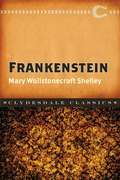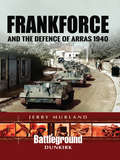- Table View
- List View
Frank Lloyd Wright on the West Coast
by Mark Anthony WilsonFrank Lloyd Wright’s buildings on the West Coast have not been thoroughly covered in print until now. Between 1909 and 1959, Wright designed a total of 38 structures up and down the West Coast, from Seattle to Southern California. These include well-known structures such as the Marin County Civic Center and Hollyhock House in Los Angeles, and many lesser-known gems such as the 1909 Stewart House near Santa Barbara.
Frank Lloyd Wright's Forgotten House: How an Omission Transformed the Architect's Legacy
by Nicholas D. HayesWhile the grandiosity of Fallingwater and elegance of Taliesin are recognized universally, Frank Lloyd Wright’s first foray into affordable housing is frequently overlooked. Although Wright began work on his American System-Built Homes (ASBH, 1911–17) with great energy, the project fell apart following wartime shortages and disputes between the architect and his developer. While continuing to advocate for the design of affordable small homes, Wright never spoke publicly of ASBH. As a result, the heritage of many Wright-designed homes was forgotten. When Nicholas and Angela Hayes became stewards of the unassuming Elizabeth Murphy House near Milwaukee, they began to unearth evidence that ultimately revealed a one-hundred-year-old fiasco fueled by competing ambitions and conflicting visions of America. The couple’s forensic pursuit of the truth untangled the ways Wright’s ASBH experiment led to the architect’s most productive, creative period. Frank Lloyd Wright’s Forgotten House includes a wealth of drawings and photographs, many of which have never been previously published. Historians, architecture buffs, and Wrightophiles alike will be fascinated by this untold history that fills a crucial gap in the architect’s oeuvre.
Frank Lloyd Wright's Hollyhock House: The Illustrated Story of an Architectural Masterpiece
by Donald HoffmannAt the behest of oil heiress Aline Barnsdall, the twentieth century's greatest architect created one of his most imaginative and controversial residential designs. Built in Hollywood in 1920–21, Hollyhock House attests to the genius of Frank Lloyd Wright. This splendid home and its construction are documented here in more than 120 illustrations — photographs, floor plans, elevations, sketches, etc. — accompanied by the author's detailed, perceptive text.Donald Hoffmann, noted Wright scholar and architectural critic, draws on a wealth of primary documents and his own direct observation not only to re-create the problems of clashing egos and rancor behind the house's turbulent history, but also to invite a true appreciation of its myriad aesthetic and architectural charms. The varied aspects of the house are captured in this lavishly illustrated tribute, which reveals the imaginatively shaped spaces, inner harmonies, daring conceptions, and exquisite details that make Hollyhock House a landmark of modern design.
Frank Lloyd Wright: Europe and Beyond
by Anthony AlofsinAsk Americans to think of a famous architect and the person they are most likely to name is Frank Lloyd Wright. Wright's work, his reputation, and his long and colorful career have made him an icon of modern American architecture. But despite his status as America's most celebrated architect, his influence throughout an active practice spanning the years 1896 to 1959 is so wide and complex that it has been difficult to grasp fully.The essays in this book look not at the United States, the context usually associated with Wright, but at countries around the globe. Anthony Alofsin has assembled a superb collection of scholars to examine Wright's importance from Japan to Great Britain, France to Chile, Mexico to Russia, and the Middle East. Interwoven in the essays are stories of champions and critics, rivals and acolytes, books and exhibitions, attitudes toward America and individualism, and the many ways Wright's ideas were brought to the world. Together the essays represent a first look at Wright's impact abroad, some from the perspective of natives of the countries discussed and others from that of informed outsiders. Of special note is Bruno Zevi's firsthand account of traveling with Wright in Italy. Zevi was instrumental in bringing Wright's ideas to Italy and in helping launch the movement for organic architecture. Of unusual interest in light of today's events in Iraq is Mina Marefat's essay on Wright's elaborate designs for a cultural center for the city of Baghdad. The Baghdad projects, which were never realized after the assassination of King Faisal II, were Wright's principal focus in his last decade.In searching out the little known rather than reexamining the well-established aspects of Frank Lloyd Wright's work, this collection is a rewarding exploration of his vision and influence.
Frank Lloyd Wright’s Fallingwater: American Architecture in the Depression Era
by Catherine W ZipfFrank Lloyd Wright’s Fallingwater explores the relationship between the economic tumult in the United States in the 1930s, Frank Lloyd Wright, and the construction of his most famous house, Fallingwater. The book reinterprets the history of this iconic building, recognizing it as a Depression-era monument that stands as a testimony to what an American architect could achieve with the right site, client, and circumstance, even in desperate economic circumstances. Using newly available resources, author Catherine W. Zipf examines Wright’s work before and after Fallingwater to show how it was influenced by the economic climate, public architectural projects of the Great Depression, and America’s changing relationship with Modernist style and technology. Including over 50 black-and-white images, this book will be of great interest to students, historians, and researchers of art, architecture, and Frank Lloyd Wright.
Frank Maxwell Brig-General, V.C., C.S.I., D.S.O. - A Memoir And Some Letters [Illustrated Edition]
by Brig.-General Francis A. Maxwell V.C.Includes the First World War Illustrations Pack - 73 battle plans and diagrams and 198 photos"If future generations desire to know what the British Regular officer was like at his best in the days of the War they will find some useful information in these pages. Brig.-General Maxwell--as he was when killed in actin.in September 1917--won the Victoria Cross in the African War, and officers of his regiment and brigade stated that he qualified for that greatest of all honours more than once in the Great War. His extraordinary personal bravery was matched by his chivalrous winning personality. "He was a King among men loved by everyone," wrote his orderly to Mrs Maxwell after his death. His letters are racy, interesting, valuable. He was one of the comparatively rare men loved war, thinking what a great and glorious life it would be "if one had no ties and love to make one look behind, instead of in front.""- Sir Cyril Falls.
Frank McClean: Godfather to British Naval Aviation
by Philip JarrettDuring aviations pioneering years Francis Kennedy McClean used his vast inherited wealth to help the now famous Short Brothers company become established as one of Britains greatest aircraft manufacturers and, in doing so, he helped the Royal Navys first pilots into the air. In effect, he was Godfather to British naval aviation.But McClean did much more than even that. He was himself a balloonist and pioneer aviator, flying with Wilbur Wright in France in December 1908. He provided the Royal Aero Club with one of the first flying grounds in the UK; personally purchased no fewer than sixteen aeroplanes from Short Brothers before the First World War, and also acted as the companys unpaid test pilot. Convinced that aviation was destined to play a vital role in the nations defence, he made his own aeroplanes freely available for training and ensured that the Navy had a suitable site from which to fly, founding Englands first naval flying school, at Eastchurch in Kent. His flight up the Thames to Westminster on 10 August 1912, during which he flew between the upper and lower spans of Tower Bridge and passed beneath the other bridges, caught the public imagination, but despite all these achievements he remained unassuming, modest and reticent. This is a fascinating and informative account of McCleans great influence on early aviation, and his achievements and significant contribution to naval aviation are revealed here for the first time.
Frank O. Etheridge: Musician of the African Diaspora
by Ben VinsonThis is a book by and about Frank O. Etheridge, an African-American musician from an age of cultural explosion. The decade after World War II saw the coming-of-age of marginalized cultures, and in North America a new voice emerged among peoples of African descent. Etheridge performed in a period when some of the greatest cultural producers of the African-American heritage assumed center-stage. From Shanghai to Singapore; from India to Africa and beyond, Frank Etheridge left us a detailed record of his travels in his unpublished manuscript. The book contains his views, insights, and international itinerary during the 1920s. His book is an important volume in the annals of African-American history, not just for its content, but for what it means and symbolizes. Its readers will journey with him, see through his eyes, understand race and racial prejudice as lived in ordinary skin, and sample culture. Some of Etheridge’s reflections and personal biases will seem like unpleasant contradictions from the way we think about racial prejudice today. However, these jarring moments of dissonance are rich learning opportunities that will connect us to his times, while unraveling a greater understanding of ourselves in our current moment. This manuscript, published for the first time, will be accompanied by editorial commentary written by Professor Ben Vinson III, and will be of great interest to students and scholars of African American history.
Frank Peace, Trouble Shooter
by Ernest HaycoxA LUSTY, ROARING NOVEL ABOUT ONE MAN’S RELENTLESS BATTLE TO GET THE RAILROAD THROUGHThis is the story of FRANK PEACE, TROUBLE SHOOTER for the Union Pacific Railroad, handpicked as the only man in the West who could get the road across a thousand miles of rugged desert and mountains, through fighting Indian territory, past the organized bands of outlaws hired to kill him, and in the face of powerful interests determined to smash him. His business was war, and every man from Omaha to Salt Lake City would become either friend or enemy before he was through.ERNEST HAYCOX is the unquestioned king of the western story. His virile, exciting books have brought him worldwide fame and have made him one of the best-selling authors of all time.
Frank Porter Graham and the 1950 Senate Race in North Carolina
by Julian M. Pleasants Augustus M. BurnsThe tumultuous North Carolina Senate primaries of 1950 are still viewed as the most bitter chapter in the state's modern political history. The central figure in that frenzied race was the appointed incumbent, Frank Porter Graham, former president of the University of North Carolina (1931-49) and liberal activist of national stature.As a Senate candidate, Graham was unrelentingly attacked for both his social activism and his racial views, and the vicious tactics used against him shocked his supporters and alarmed national observers. Peeling away the myths that have accumulated over the years, the authors present the first thoroughly researched account of Graham's eventual defeat by Raleigh attorney Willis Smith. The result, a balanced study of North Carolina politics at mid-century, is a convincing explanation of the 1950 election.Using the campaign as a prism, the authors assess the factional struggles within the state, showing that Graham was defeated by a massive loss of support among white voters in eastern North Carolina. The principal force behind this switch was the fear promulgated by the Smith campaign that a vote for Graham was a vote to end statutory segregation in North Carolina. The authors also offer the fullest portrait to date of Frank Porter Graham as political candidate and social reformer. They examine his career as an educator and public activist, the steps that led to his unorthodox appointment, and his strengths and weaknesses as a political candidate.Frank Porter Graham and the 1950 Senate Race in North Carolina is based on manuscript materials never before examined, on interviews with more than 50 campaign participants and associates of both Graham and Smith, and on a thorough analysis of newspaper coverage and campaign literature.Originally published in 1990.A UNC Press Enduring Edition -- UNC Press Enduring Editions use the latest in digital technology to make available again books from our distinguished backlist that were previously out of print. These editions are published unaltered from the original, and are presented in affordable paperback formats, bringing readers both historical and cultural value.
Frank Porter Graham: Southern Liberal, Citizen of the World
by William A. LinkFrank Porter Graham (1886–1972) was one of the most consequential white southerners of the twentieth century. Born in Fayetteville and raised in Charlotte, Graham became an active and popular student leader at the University of North Carolina. After earning a graduate degree from Columbia University and serving as a marine during World War I, he taught history at UNC, and in 1930, he became the university's fifteenth president. Affectionately known as "Dr. Frank," Graham spent two decades overseeing UNC's development into a world-class public institution. But he regularly faced controversy, especially as he was increasingly drawn into national leadership on matters such as intellectual freedom and the rights of workers. As a southern liberal, Graham became a prominent New Dealer and negotiator and briefly a U.S. senator. Graham's reputation for problem solving through compromise led him into service under several presidents as a United Nations mediator, and he was outspoken as a white southerner regarding civil rights. Brimming with fresh insights, this definitive biography reveals how a personally modest public servant took his place on the national and world stage and, along the way, helped transform North Carolina.
Frank Ramsey and the Realistic Spirit (History of Analytic Philosophy)
by S. J. MethvenFrank Ramsey and the Realistic Spirit.
Frank Ramsey and the Realistic Spirit (History of Analytic Philosophy)
by Steven MethvenThis book attempts to explicate and expand upon Frank Ramsey's notion of the realistic spirit. In so doing, it provides a systematic reading of his work, and demonstrates the extent of Ramsey's genius as evinced by both his responses to the Tractatus Logico-Philosophicus, and the impact he had on Wittgenstein's later philosophical insights.
Frank Roney, Irish Rebel and California Labor Leader: An Autobiography
by Ira B. CrossThis title is part of UC Press's Voices Revived program, which commemorates University of California Press’s mission to seek out and cultivate the brightest minds and give them voice, reach, and impact. Drawing on a backlist dating to 1893, Voices Revived makes high-quality, peer-reviewed scholarship accessible once again using print-on-demand technology. This title was originally published in 1931.
Frank Zappa's America
by Bradley MorganFrom his early albums with the Mothers of Invention, Frank Zappa established a reputation as a musical genius who pushed the limits of culture throughout the 1960s and 1970s, experimenting with a blend of genres in innovative and unheard-of ways. Not only did his exploratory styles challenge the expectations of what popular music could sound like, but his prolific creative endeavors also shaped how audiences thought about the freedom of artistic expression. In Frank Zappa’s America, Bradley Morgan casts the artist as an often-misunderstood figure who critiqued the actions of religious and political groups promoting a predominantly white, Christian vision of the United States. A controversial and provocative satirist, often criticized for the shocking subject matter of his songs, Zappa provided social commentary throughout his career that spoke truth to power about the nefarious institutions operating in the lives of everyday Americans. Beginning in the late 1970s, his music frequently addressed the rise of extremist religious influence in American politics, specifically white Christian nationalism. Despite commercial and critical pressure, Zappa refused to waver in his support for free speech during the era of Reagan and MTV, including his pointed testimony before the U.S. Senate at the Parents Music Resource Center (PMRC) hearings. Throughout the 1980s, and until his death in 1993, Zappa crafted his art form to advocate for political engagement, the security of individual liberties, and the advancement of education. Music became his platform to convey progressive views promoting the rights of marginalized communities most at risk in a society governed by the principles of what he perceived as Christian radicalism. Frank Zappa’s America examines the musician’s messaging through song, tracing the means by which Zappa created passionate, at times troubling, art that combats conservativism in its many manifestations. For readers in the twenty-first century, his music and public advocacy demonstrate the need to preserve democracy and the voices that uphold it.
Frank and Al: FDR, Al Smith, and the Unlikely Alliance That Created the Modern Democratic Party
by Terry Golway"This is history told the old-fashioned way. The book is only as long as it needs to be, the adroit narrative full of heroes (Smith, Roosevelt, big-city Democratic bosses) and villains (William Randolph Hearst, William Jennings Bryan, the Ku Klux Klan). The scenes are vivid and the anecdotes plentiful." —The Wall Street Journal"Frank & Al is the latest of Mr. Golway’s several captivating books on New York politics. He delivers once again, with a timely narrative on the centennial of Smith’s first election as governor." —The New York Times "The tangled, tragic story of Al Smith and Franklin Roosevelt is one of the great tales of American politics, and Terry Golway has told it beautifully. This is a joyous book... an especially important book now." —Joe Klein"I highly recommend this fascinating and enlightening book." —Franklin D. Roosevelt, III"Beautifully written...The book is must reading for anyone interested in the history of American politics and the rise of the country’s welfare state." —Robert Dallek, author of An Unfinished Life: John F. Kennedy, 1917-1963“A marvelous portrait... Highly recommend!” —Douglas Brinkley, author of Rightful Heritage: Franklin D. Roosevelt and the Land of AmericaThe inspiring story of an unlikely political partnership—between a to-the-manor-born Protestant and a Lower East Side Catholic—that transformed the Democratic Party and led to the New DealIn the late 19th and early 20th centuries, the Democratic Party was bitterly split between its urban machines—representing Catholics and Jews, ironworkers and seamstresses, from the tenements of the northeast and Midwest—and its populists and patricians, rooted in the soil and the Scriptures, enforcers of cultural, political, and religious norms. The chasm between the two factions seemed unbridgeable. But just before the Roaring Twenties, Al Smith, a proud son of the Tammany Hall political machine, and Franklin Roosevelt, a country squire, formed an unlikely alliance that transformed the Democratic Party. Smith and FDR dominated politics in the most-powerful state in the union for a quarter-century, and in 1932 they ran against each other for the Democratic presidential nomination, setting off one of the great feuds in American history. The relationship between Smith and Roosevelt, portrayed in Terry Golway's Frank and Al, is one of the most dramatic untold stories of early 20th Century American politics. It was Roosevelt who said once that everything he sought to do in the New Deal had been done in New York under Al Smith when he was governor in the 1920s. It was Smith who persuaded a reluctant Roosevelt to run for governor in 1928, setting the stage for FDR’s dramatic comeback after contracting polio in 1921. They took their party, and American politics, out of the 19th Century and created a place in civic life for the New America of the 20th Century.
Frank's Home
by Richard Nelson"A thoroughly invigorating, tightly focused piece of Chekhovian drama, wherein chatter about work and art . . . fail to mask deep vulnerability."-Chicago TribuneA play about Frank Lloyd Wright set in the summer of 1923, when the great architect has recently left Chicago for California, hoping to mend his relationship with his adult children. Richard Nelson brings to life two great architectural demigods, Wright and Louis Sullivan, only to show their all-too-human frailties.Richard Nelson's plays include Rodney's Wife, Goodnight Children Everywhere, Some Americans Abroad, Franny's Way, New England, and James Joyce's The Dead (with Shaun Davey), winner of the Tony Award for Best Book of a Musical.
Frankenstein (Cultographies)
by Robert HortonJames Whale's Frankenstein (1931) spawned a phenomenon that has been rooted in world culture for decades. This cinematic Prometheus has generated countless sequels, remakes, rip-offs, and parodies in every media, and this granddaddy of cult movies constantly renews its followers in each generation. Along with an in-depth critical reading of the original 1931 film, this book tracks Frankenstein the monster's heavy cultural tread from Mary Shelley's source novel to today's Internet chat rooms.
Frankenstein (S.F. MASTERWORKS)
by Mary ShelleyBrilliant, driven Victor Frankenstein has at last realised his greatest ambition. The scientist has succeeded in creating intelligent life. But when his creature first stirs, Frankenstein realises he has made a monster. And, abandoned by its maker and shunned by everyone who sees it, the Doctor's creation sets out to destroy him and all that he holds dear.Mary Shelley's FRANKENSTEIN remains one of the greatest horror stories ever written, a book that chillingly captures the unforeseen terror of playing God. And the heart-stopping fear of being pursued by a powerful, relentless killer.
Frankenstein and STEAM: Essays for Charles E. Robinson
by Brian Bates Susan J. Wolfson Mark A. McCutcheon Lisa Crafton Siobhan Watters Lisbeth Chapin L. Adam Mekler Robin HammermanCharles E. Robinson, Professor Emeritus of English at The University of Delaware, definitively transformed study of the novel Frankenstein with his foundational volume The Frankenstein Notebooks and, in nineteenth century studies more broadly, brought heightened attention to the nuances of writing and editing. Frankenstein and STEAM consolidates the generative legacy of his later work on the novel's broad relation to topics in science, technology, engineering, arts, and mathematics (STEAM). Seven chapters written by leading and emerging scholars pay homage to Robinson's later perspectives of the novel and a concluding postscript contains remembrances by his colleagues and students. This volume not only makes explicit the question of what it means to be human, a question Robinson invited students and colleagues to examine throughout his career, but it also illustrates the depth of the field and diversity of those who have been inspired by Robinson's work. Frankenstein and STEAM offers direction for continuing scholarship on the intersections of literature, science, and technology. Published by the University of Delaware Press. Distributed worldwide by Rutgers University Press.
Frankenstein: A Cultural History
by Susan Tyler HitchcockFrankenstein began as the nightmare of an unwed teenage mother in 1816 in Geneva, Switzerland. When the moral universe was shifting and advances in scientific knowledge promised mankind dominion over that which had been God's alone, Mary Shelley envisioned a story of human presumption and its misbegotten consequences. Now, two centuries later, that story is constantly retold and reinterpreted, from Halloween cartoons to ominous allusions in the public debate, capturing and conveying meaning central to our consciousness today and our concerns for tomorrow. From Victorian theater to Boris Karloff with neck bolts, to invocations at the President's Council on Bioethics, the monster and his myth have inspired everyone from philosophers to philatelists. This is a lively and eclectic cultural history, illuminated with dozens of pictures and illustrations and told with skill and humor. Susan Tyler Hitchcock uses film, literature, history, science, and even punk music to help us understand the meaning of this monster made by man.
Frankenstein: How A Monster Became An Icon: The Science And Enduring Allure Of Mary Shelley's Creation
by Sidney Perkowitz Eddy Von MuellerFew creations have risen from literary origins to reach world-wide importance like Frankenstein. This landmark volume celebrates the bicentenary of Mary Shelley's creation and its indelible impact on art and culture. The tale of a tormented creature created in a laboratory began on a rainy night in 1816 in the imagination of a nineteen-year-old Mary Wollstonecraft Shelley, newly married to the celebrated Romantic poet Percy Shelley. Since its publication two years later, in 1818, Frankenstein: Or, the Modern Prometheus has spread around the globe through every possible medium and variation. Frankenstein has not been out of print once in 200 years. It has appeared in hundreds of editions, perhaps more than any other novel. It has inspired a multitude of stage and screen adaptations, the latest appearing just last year. “Frankenstein” has become an indelible part of popular culture, and is shorthand for anything bizarre and human-made; for instance, genetically modified crops are “Frankenfood.” Conversely, Frankenstein’s monster has also become a benign Halloween favorite. Yet for all its long history, Frankenstein's central premise—that science, not magic or God, can create a living being, and thus these creators must answer for their actions as humans, not Gods—is most relevant today as scientists approach creating synthetic life. In its popular and cultural weight and its expression of the ethical issues raised by the advance of science, physicist Sidney Perkowitz and film expert Eddy von Muller have brought together scholars and scientists, artists and directions—including Mel Brooks—to celebrate and examine Mary Shelley’s marvelous creation and its legacy as the monster moves into his next century.
Frankenstein: Or The Modern Prometheus
by Mary Shelley"Enduring power.” -The New York TimesPackaged in handsome and affordable trade editions, Clydesdale Classics is a new series of essential literary works. The series features literary phenomena with influence and themes so great that, after their publication, they changed literature forever. From the musings of literary geniuses such as Mark Twain in The Adventures of Huckleberry Finn, to the striking personal narratives from Harriet Jacobs in Incidents in the Life of a Slave Girl, this new series is a comprehensive collection of our literary history through the words of the exceptional few.Frankenstein, or The Modern Prometheus, is often referred to as one the most important literary works of all time. Having been adapted and reprinted thousands of times, and often cited as the birth of the gothic novel and the science fiction genre, Frankenstein has captivated readers for centuries. It is the haunting tale of Victor Frankenstein, a young scientist who creates a grotesque and cognizant being through a scientific experiment. "The monster,” as it’s frequently referred to throughout the novel, consists of sewn body parts from multiple cadavers being used for scientific research. On a dark, stormy night, the creature is brought to life by being shocked with an electrical current harnessed from a lightning storm. The novel explores scientific practices such as galvanism, as well as the ethical repercussions of bringing the deceased back to life.With its grim, but gripping narrative, Frankenstein is the classic story of life and death, humanity and monstrosity, and blurring the lines in between.
Frankforce and the Defence of Arras 1940 (Battleground Dunkirk)
by Jerry MurlandThere is no other city in France that has the same associations in time of conflict that the British have with Arras. Since the campaigns of John Churchill, 1st Duke of Marlborough, in the early 18th century, British soldiers have fought in and around Arras, occasionally as an enemy but, more often, as defenders of French and Allied democracy. Battlefield visitors to the area will immediately recognize the names of towns and villages that were as significant to the men of Marlboroughs army as they were to those who fought in the First and Second World Wars.This book serves both as guide to the Second World War battlefields that surround the city and its environs as well as detailing the actions of the British armored attack of 21 May 1940. The book looks at the strategic situation that led up to the famous Arras counterstroke and, using material that has not been published before, examines the British and German actions between 20 and 23 May. The only Victoria Cross action that took place during this time is looked at in detail; as is the fighting that took place in Arras and during the breakout.Despite its shortcomings, the counterstroke achieved the essential element of surprise and caused widespread alarm amongst the German command and hit Rommels 7th Panzer Division at precisely the moment when his armored units were ahead of the infantry and gunners. The British infantry fought well and both the Durham battalions were fortunate that their commanding officers and senior NCOs were men who had already fought in one conflict and possessed the determination to rally their less experienced junior ranks and fight on regardless. Such was the case with the two tank battalions, although sadly they lost both their commanding officers and over half the tanks that went into the engagement. The attack did enable the British to tighten their hold on Arras albeit temporarily and, as is often cited, built doubts in the minds of German High Command as to the speed of their advance and contributed to the subsequent Hitler halt order of 24-27 May.The author has gone to some lengths to track down accounts from those individuals who served in the area during May 1940 and fought the enveloping tide of the German advanceThe book is supported by three car tours, one of which takes the visitor along the tragic path taken by the Tyneside Scottish on 20 May and two walking routes, which concentrate on Arras.137 black and white photographs (integrated) and a number of maps derived from regimental histories; and six tour maps provide the battlefield visitor with illustrations of the battlefields as they were in 1940 and as they are today.
